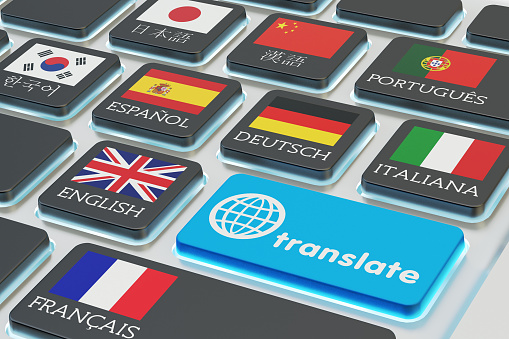Translation vs Interpretation: What's the Difference?
Choosing the right language service for your needs
The Core Difference:
Translation works with written text. Interpretation handles spoken language in real-time.
Learn more about how InterMIND's AI interpretation works in our platform.
Quick Comparison
Translation
Written • Deliberate • Polished
- Works with text
- Time for research
- Multiple revisions
- Permanent output
Interpretation
Spoken • Real-time • Dynamic
- Handles speech
- Instant delivery
- No second chances
- Live performance
Translation: The Written Word
What Is Translation?
Converting written content from one language to another while preserving meaning, tone, and cultural nuances. Think: documents, websites, books.
Key Characteristics
Days or weeks to research, revise, and polish
Zero tolerance for errors in legal/medical contexts
Adjusts idioms, humor, and cultural references
Uses CAT tools, translation memories, glossaries
Common Translation Types
| Type | Examples | Priority |
|---|---|---|
| Literary | Books, poetry, plays | Artistic voice |
| Technical | Manuals, specifications | Accuracy |
| Legal | Contracts, patents | Zero ambiguity |
| Medical | Clinical trials, patient records | Patient safety |
| Marketing | Ads, slogans, campaigns | Emotional impact |
| Localization | Websites, software, apps | Cultural fit |
Interpretation: The Spoken Word
What Is Interpretation?
Real-time oral conversion of spoken language. Think: conferences, medical consultations, business meetings.
Key Characteristics
No pause, no research, no revisions
Split attention: listen, process, speak simultaneously
Clear articulation, confidence, stamina
Interpreters switch every 20-30 minutes
Interpretation Methods
🎧 Simultaneous
When: Large conferences, UN meetings
How: Interpreter speaks while source continues
Needs: Booths, headsets, equipment
✋ Consecutive
When: Business meetings, legal proceedings
How: Speaker pauses for interpretation
Needs: Note-taking system, more time
🤫 Whispered (Chuchotage)
When: 1-2 listeners only
How: Whispers translation to individuals
Needs: No equipment, physically demanding
💻 Remote (Video/Phone)
When: Healthcare, legal, distance
How: Interpretation via video/phone
Needs: Stable tech, clear audio
Skills: Not Interchangeable
📝 Translator Skills
- Excellent writing ability
- Research proficiency
- Attention to detail
- Time management
- CAT tool expertise
- Subject matter knowledge
🎯 Interpreter Skills
- Split attention ability
- Stress management
- Cultural intelligence
- Physical stamina
- Quick improvisation
- Memory techniques
Technology Impact
🤖 For Translation


Machine Translation (MT)
- Google Translate, DeepL, GPT-4
- Great for gisting, informal use
- Requires human post-editing professionally
- Struggles with context and nuance
CAT Tools
- Translation memories for consistency
- Terminology management
- Quality assurance checks
- Team collaboration
🎙️ For Interpretation


AI Real-Time Interpretation
- Automatic speech recognition + MT
- Instant captions and translations
- Cost-effective for large events
- Still challenged by accents, jargon
Hybrid Solutions
- AI first draft + human refinement
- Reduces costs, maintains quality
- Enables more language pairs
When to Use Each
✅ Choose Translation
- Multilingual websites/apps
- Published books, reports
- Legal documents
- Marketing materials
- Technical documentation
- E-learning courses
✅ Choose Interpretation
- International conferences
- Business negotiations
- Medical consultations
- Training sessions
- Legal proceedings
- Live broadcasts
🔄 Use Both (Hybrid)
- International conferences
- Legal cases (documents + court)
- Medical research collaborations
- Global product launches
- M&A transactions
Professional Standards
ISO Certifications for Translation
| Standard | What It Covers | Who Needs It |
|---|---|---|
| ISO 17100:2015 | Translation service requirements | Agencies, corporate departments |
| ISO 18587:2017 | Machine translation post-editing | Companies using MT workflows |
| ISO 20771:2020 | Legal translation | Law firms, courts, government |
Certifications for Interpretation
| Program | Focus | Region |
|---|---|---|
| AIIC | Conference interpretation | International |
| CCHI | Healthcare interpretation | USA |
| Federal Court | Legal interpretation | USA (Spanish) |
| State Court | Legal interpretation | USA (varies by state) |
Pricing Differences
Translation Pricing
- Per word, page, or project
- Rush jobs = premium rates
- Volume discounts available
- Review stages add cost
Interpretation Pricing
- Hourly or daily rates
- Minimum fees (half/full day)
- Equipment rental extra
- Travel expenses added
Common Myths Debunked
Myth: "Any bilingual person can translate or interpret"
Reality: Professional language services require years of training, specialized skills, and subject expertise beyond simple fluency.
Myth: "Google Translate is good enough"
Reality: MT works for basic gisting, but professional human oversight is essential for accuracy, context, and cultural nuance.
Myth: "Interpretation is just verbal translation"
Reality: Interpretation involves complex cognitive processes, cultural mediation, and split-second decisions that go far beyond word substitution.
Myth: "Full automation is coming soon"
Reality: While AI advances rapidly, human creativity, cultural understanding, and contextual judgment remain irreplaceable for high-stakes communication.
Best Practices
📄 Working with Translators
- Provide context and background
- Clarify target audience
- Allow adequate time
- Share terminology glossaries
- Be available for questions
- Plan for review cycles
🗣️ Working with Interpreters
- Share agenda in advance
- Brief on technical terms
- Provide speaker names
- Ensure proper equipment
- Speak clearly, moderate pace
- Allow interpretation time
The Bottom Line
Translation and interpretation both break down language barriers, but through different means:
- Translation = Careful, written, revised, permanent
- Interpretation = Instant, spoken, no revisions, ephemeral
Choose based on your content type (written vs spoken), timeline (days vs real-time), and permanence needs (published vs live).
For complex projects—like international conferences or legal cases—you'll often need both services working together with consistent terminology and messaging.
Remember
Quality language services are an investment in accurate communication, cultural understanding, and building trust across languages. Choose certified professionals and allow adequate time and resources for best results.
Want to experience real-time AI interpretation? Try InterMIND's video platform or learn more about our technology.